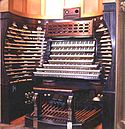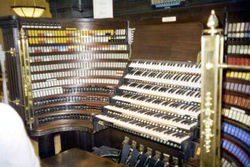Organist and horn player, the gladiator mosaic at the Roman villa in Nennig, Germany (9291661708)
The beginning and the end of the Roman games would be accompanied by the sound of trumpets and organs. It is therefore to be expected that these motifs also appear on the gladiator mosaic.
The artist has depicted the water organ, know in the ancient world since 300 BC. The 27 organ-pipes rest on a hexagonal podium which also serves to store water for the organ. A cylindrical air pump is located at each side of the podium, at the bottom ends of which two levels used for driving the hydraulic pistons are visible. The technical principal corresponds to the modern organ whereby the water has a regulatory effect on the air pressure. The organist plays the keyboard situated behind the pipes. The sound of the organ would have resembled that of a large harmonium. The air supply would have been maintained by additional assistants.
The curved horn, which is braced and supported on the shoulder of the player by a cross bar, is a cornu.Relevante Bilder










































Relevante Artikel
OrgelEine Orgel ist ein über Tasten spielbares Musikinstrument. Sie gehört zu den Aerophonen. Zur Abgrenzung gegenüber elektronischen Orgeln wird sie auch Pfeifenorgel genannt. .. weiterlesen
Geschichte der OrgelDie Orgel ist ein über Tasten spielbares Musikinstrument, welches eine über 2000-jährige Geschichte aufweist. Orgeln sind seit der Antike bekannt und haben sich besonders im Barock und zur Zeit der Romantik zu ihrer heutigen Form entwickelt. Die Gesamtanlage der Orgel, die künstlerische Gestaltung des Orgelgehäuses, die klangliche Gestaltung und die technische Anlage sind über viele Epochen der Kunst- und Technikgeschichte hinweg verändert und beeinflusst worden. .. weiterlesen
